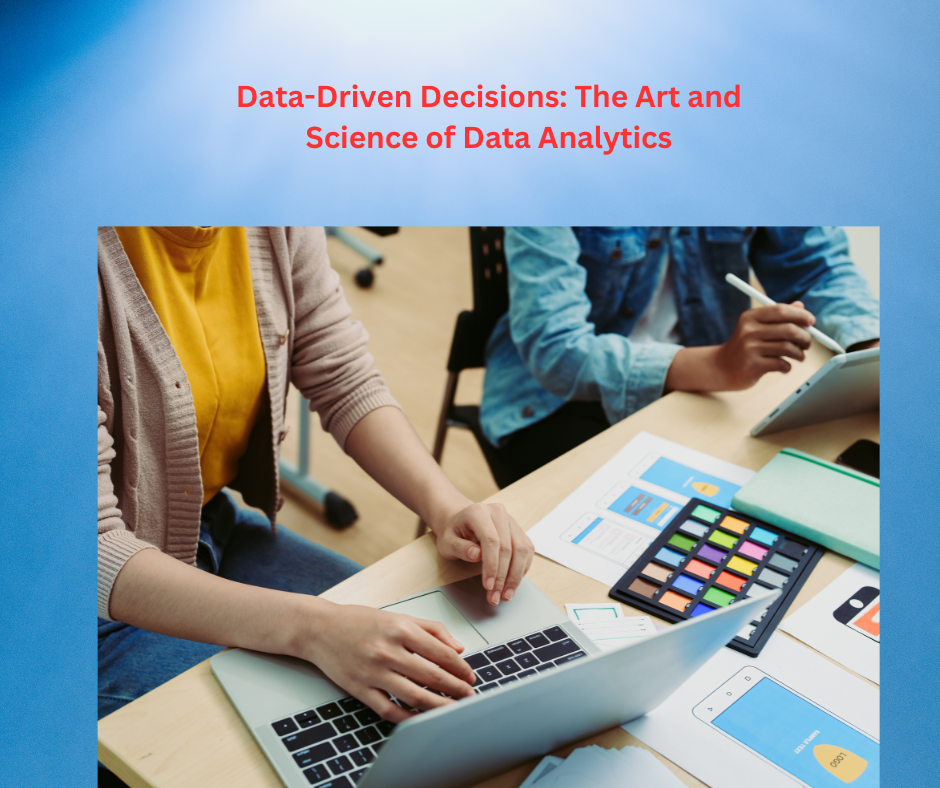Data-Driven Decisions: The Art and Science of Data Analytics
 Ruhi Parveen
Ruhi Parveen
In today's data-rich environment, organizations have unprecedented access to vast amounts of information. Making sense of this data and using it to drive decisions is a critical capability for businesses aiming to maintain a competitive edge. This article explores the art and science of data analytics, explaining its importance, key concepts, methodologies, and best practices for making data-driven decisions.
Introduction to Data Analytics
It combines various techniques from statistics, computer science, and machine learning to transform data into actionable insights.
Descriptive Analytics: What happened?
Diagnostic Analytics: Why did it happen?
Predictive Analytics: What will happen?
Prescriptive Analytics: What should we do about it?
These types of analytics help organizations understand past performance, identify root causes, predict future outcomes, and make informed decisions.
The Importance of Data-Driven Decisions
Competitive Advantage
Organizations that leverage data analytics can outperform their competitors by making more informed decisions. Data-driven companies are better equipped to identify market trends, customer preferences, and operational inefficiencies, enabling them to adapt quickly and innovate continuously.
Improved Efficiency
Data analytics helps streamline operations by identifying bottlenecks and optimizing processes. By analyzing workflow data, organizations can improve resource allocation, reduce costs, and enhance productivity.
Enhanced Customer Experience
Understanding customer behavior through data analytics allows businesses to personalize their offerings and improve customer satisfaction. Tailored marketing campaigns, product recommendations, and customer support initiatives can significantly enhance the customer experience.
Risk Management
By analyzing historical data, organizations can predict potential issues and implement preventive measures. This proactive approach helps in minimizing financial losses and safeguarding the company's reputation.
Key Concepts in Data Analytics
Data Collection
The foundation of data analytics is high-quality data.
Internal Systems: Transactional databases, CRM systems, ERP systems.
External Sources: Social media, market research reports, third-party databases.
IoT Devices: Sensors, smart devices, and other connected technologies.
Ensuring data accuracy, completeness, and relevance is crucial for reliable analysis.
Data Transformation
This includes normalizing data, aggregating values, and creating new features that enhance the analytical process.
Data Analysis
Data analysis encompasses various techniques to explore and interpret data. Common methods include:
Statistical Analysis: Identifying trends, correlations, and patterns.
Data Mining: Discovering hidden patterns and relationships using algorithms.
Machine Learning: Building predictive models to forecast future outcomes.
Data Visualization
Data visualization presents data in graphical formats, such as charts, graphs, and dashboards. Effective visualization makes complex data more accessible and understandable, helping stakeholders grasp insights quickly.
Methodologies in Data Analytics
Descriptive Analytics
Summary Statistics: Measures like mean, median, mode, and standard deviation.
Data Aggregation: Combining data from multiple sources to provide a comprehensive overview.
Data Visualization: Using charts and graphs to highlight key trends and patterns.
Diagnostic Analytics
Diagnostic analytics goes a step further to explain why certain events occurred. Techniques include:
Drill-Down Analysis: Exploring detailed data layers to uncover root causes.
Correlation Analysis: Identifying relationships between variables.
Regression Analysis: Examining how changes in one variable affect another.
Predictive Analytics
Predictive analytics uses historical data to forecast future outcomes. Techniques include:
Time Series Analysis: Analyzing data points collected over time to identify trends and seasonal patterns.
Machine Learning Models: Using algorithms like regression, decision trees, and neural networks to predict future events.
Scenario Analysis: Evaluating potential future scenarios based on different assumptions.
Prescriptive Analytics
Prescriptive analytics recommends actions based on predictive insights. Techniques include:
Optimization Models: Identifying the best course of action given constraints and objectives.
Simulation: Running what-if scenarios to evaluate the impact of different decisions.
Decision Trees: Mapping out possible outcomes and associated probabilities to guide decision-making.
Best Practices for Data-Driven Decision Making
Define Clear Objectives
Start with a clear understanding of the problem you want to solve or the decision you need to make. Defining specific, measurable objectives will guide your data collection and analysis efforts.
Ensure Data Quality
Invest in data quality management to ensure your data is accurate, complete, and relevant.
Use the Right Tools
Choose analytics tools that align with your objectives and technical capabilities. Popular tools include:
Business Intelligence (BI) Platforms: Tableau, Power BI, Qlik.
Statistical Software: R, SAS, SPSS.
Machine Learning Frameworks: TensorFlow, Scikit-learn, PyTorch.
Foster a Data-Driven Culture
Encourage a culture where data-driven decision-making is valued and supported. Provide training and resources to help employees develop analytical skills and understand the importance of data.
Collaborate Across Teams
Data analytics should be a collaborative effort involving multiple departments. By sharing insights and working together, teams can make more informed decisions that align with the organization's overall strategy.
Monitor and Iterate
Data-driven decision-making is an ongoing process. Continuously monitor your analytics efforts, measure the impact of your decisions, and iterate based on new data and insights.
Conclusion
Data-driven decisions are essential for organizations aiming to thrive in today's competitive landscape. By leveraging the art and science of data analytics, businesses can gain valuable insights, improve efficiency, enhance customer experiences, and manage risks effectively.
Understanding key concepts such as data collection, cleaning, transformation, and analysis, and employing methodologies like descriptive, diagnostic, predictive, and prescriptive analytics, empowers organizations to make informed decisions. Adopting best practices, including defining clear objectives, ensuring data quality, using the right tools, fostering a data-driven culture, collaborating across teams, and continuously monitoring and iterating, will maximize the benefits of data analytics. Enrolling in a Data Analytics Training Course in Delhi, Noida, Nagpur, Mumbai, Indore, and other parts of India can help professionals and organizations develop these essential skills and practices.
As technology advances and the volume of data continues to grow, the ability to make data-driven decisions will become even more critical. Organizations that embrace data analytics and integrate it into their decision-making processes will be well-positioned to succeed in the future.
Subscribe to my newsletter
Read articles from Ruhi Parveen directly inside your inbox. Subscribe to the newsletter, and don't miss out.
Written by

Ruhi Parveen
Ruhi Parveen
I am a Digital Marketer and Content Marketing Specialist, I enjoy technical and non-technical writing. I enjoy learning something new.